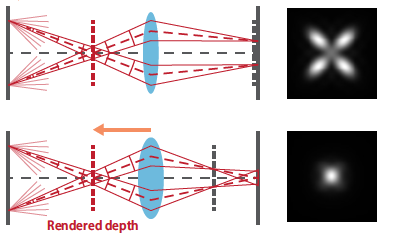
Light field (LF) displays are a promising 3D display technology to mitigate the vergence-accommodation conflict. Recently, we have proposed a simulation framework to model an LF display system. It has predicted that the in-focus optical resolution on the retina would drop as the relative depth of a rendered image to the display-specific optical reference depth grows. In this study, we examine the empirical optical resolution of a near-eye LF display prototype by capturing rendered test images and compare it to simulation results based on the previously developed computational model. We use an LF display prototype that employs a time-multiplexing technique and achieves a high angular resolution of 6-by-6 viewpoints in the eyebox. The test image is rendered at various depths ranging 0–3 diopters, and the optical resolution of the best-focus images is analyzed from images captured by a camera. Additionally, we compare the measurement results to the simulation results, discussing theoretical and practical limitations of LF displays.

We propose 3D display that scans light rays from projector and enables stereoscopic display by arranging a number of long and thin mirror scanners with a gap and spinning each mirror scanner. This proposal aims at large-screen 3D display that allows multiple people to observe simultaneously with the naked eye. In previous study, multi-projection type 3D display was proposed as largescreen 3D display. However, many projectors make installation and adjustment complicated. Therefore, we have proposed 3D display that can display large screen with single projector in the past. However, there is a problem that the screen vibrates due to the screen swing mechanism, the scanning speed cannot be increased, and the displayed image appears to flicker. Our new proposed method can reduce the screen vibration by the spin mechanism, increase the scanning speed, and prevent the displayed image from flickering. Computer simulation was performed to confirm the principle of the proposed method, and it was confirmed that appropriate parallax could be presented. The necessary conditions and problems when manufacturing the actual machine were considered, and the prototype was designed.

We propose a new optical system of glasses-free spherical 3D display and validity of the system is confirmed in this paper. The proposal display is light field display; a capable method to show 3D images to multiple viewers at once and perform complicated optical effect like occlusion effect. The proposal system is also capable to perform motion parallax effect in multiple directions (full-parallax). The proposal system is based on time-division multiplexing. The optical system consists of a rotating specially designed sphere-shaped flat mirror array and a high-speed projector. The rotating mirror array reflects rays from the projector to various angles. By controlling the intensity of the rays with the projector properly, a 3D image can be seen in the mirror array. From the results of the optical computer simulations using ray tracing method, expected 3D image was observed and we confirmed availability of the system as the 3D display. A prototype was developed using 3D printing and feasibility of the system was also confirmed. Additionally, color display of the same method was developed using 3 high-speed projectors.